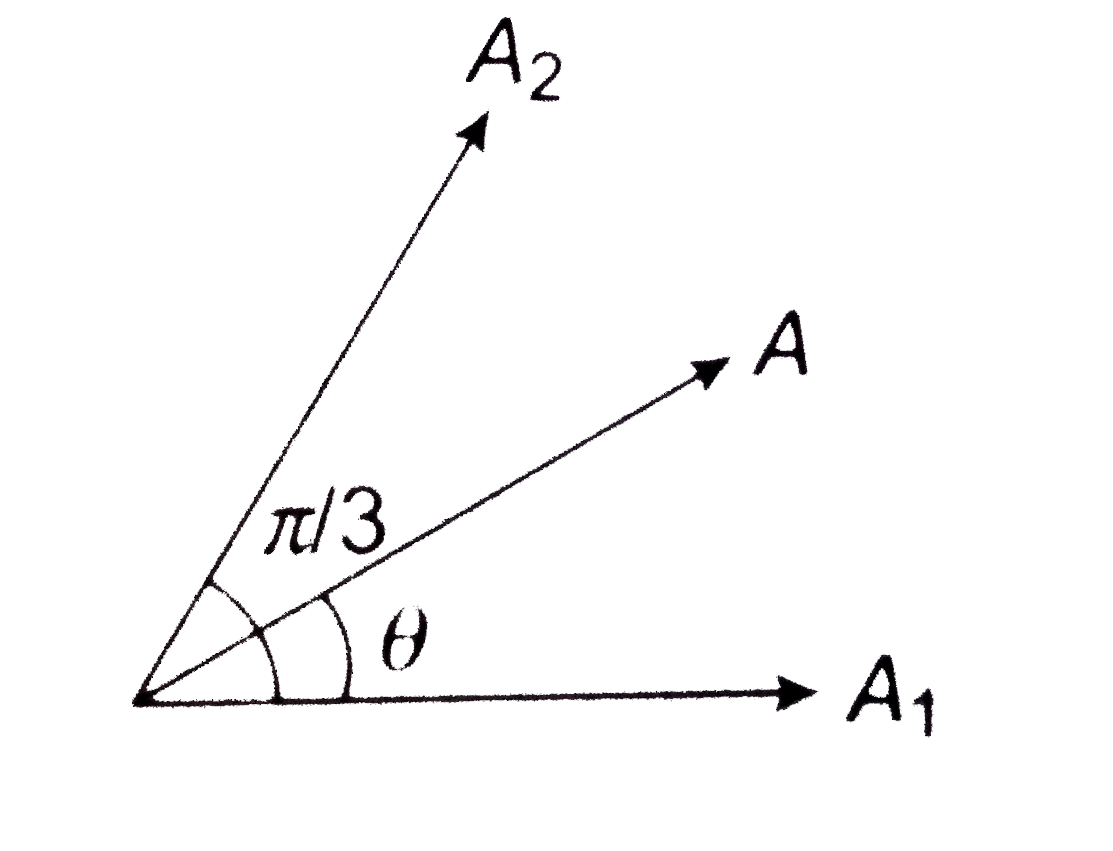(a) A particle is subjected to two simple harmonic motions
x1=A1sinωt and x2=A2sin(ωt+π/3).
Find (i) the displacement at t=0, (ii) the maximum speed of the particle and (iii) the maximum acceleration of the particle.
(b) A particle is subjected to two simple harmonic motions, one along the x-axis and the other on a line making an angle of 45∘ with the x-axis. The two motions are given by
xy=x0sinωt and s=s0sinωt
Find the amplitude of the resultant motion.
(a) x1=A1sinωt, x2=A2sin(ωt+π/3)
x=x1+x2=Asin(ωt+ϕ)

A=√A21+A22+2A1A2cos(ϕ=π/3)
=(A21+A22+A1A2)12
tanθ=A2sinπ/3A1+A2cosπ3=A2×√3/2A1+A2×1/2
=√3A22A1+A2
(i) x=Asin(ωt+θ)
At t=0, x=Asinθ
=(A21+A22+A1A2)12√A2(4A21+A22+4A1A2+3A22)12
=√3A22
OR
t=0, x1=A1sinωt=0,
x2=A2sin(ωt+π/3)=√3A22
x=x1+x2=A2√32
(ii) vmax=ωA=ω(A21+A22+A1A2)12
(iii) amax=ω2A=ω2(A21+A22+A1A2)12
(b) x=x0sinωt along x-axis
s=s0sinωt along y=x line
component of s along coordinate axes
x′=s0sinωtcos45∘=s0√2ωt
y′=s0sinωtsin45∘=s0√2sinωt
X=x+x′=(x0+s0√2)sinωt, Y=y′=s0√2sinωt
r=√X2+Y2=⎡⎣(x0+s0√2)2+(s0√2)2⎤⎦12sinωt
Resultant amplitude
=⎡⎣(x0+s0√2)2+(s0√2)2⎤⎦12=[x20+s20+√2x0s0]12
Topper's Solved these Questions
Similar Questions
A particle is subjected to two simple harmonic motions, one along the X-axis and the other on a line making an angle of 45∘ with the X-axis. The two motions are given by
x=x0sinωt and s=s0sinωt.
find the amplitude of the resultant motion.View SolutionA partical is subjucted to two simple harmonic motions
x1=A1sinωt
and x2=A2sin(ωt+π/3)
Find(a) the displacement att=0, (b) the maximum speed of the partical and ( c) the maximum acceleration of the partical.View Solution
Knowledge Check
- Question 1 - Select One or More
A 20g particle is subjected to two simple harmonic motions x1=2sin10t,x2=4sin(10t+π3). Where x1 and x2 are in metres and t is in seconds.
Athe displacement of the particle at t=0 will be 2√3 mBmaximum speed of the particle will be 20√7msCMagnitude of maximum acceleration of the particle will be 200√7ms2DEnergy of the result motion will be 28 J - Question 2 - Select One or More
A particle is subjected to two simple harmonic motions along x and y directions according to x=3sin100πt, y=4sin100πt.
AMotion of particle will be on ellipse travelling in clockwise direction.BMotion of particle will be on a straight line with slope 43CMotion will be simple harmonic motion with amplitude 5.DPhase difference between two motions is π2 - Question 3 - Select One
A particle is subjected to two simple harmonic motions x1=4sin(100πt)andx2==3sin(100πt+π2) Then maximum acceleration of the particle is
A104 unitB6.0×105 unitC7.0×106unitD4×103 unit
A particle is subjected to two simple harmonic motions
x1=A1sinωt
andx2=A2sin(ωt+π3)
Find a the displacement at t=0, b. the maxmum speed of the particle and c. the maximum acceleration of the particleView SolutionA particle is subjected to two simple harmonic motions.
x1=4.0sin(100πt) and x2=3.0sin(100πt+π3)
Find
(a) the displacement at t=0
(b) the maximum speed of the particle and
(c ) the maximum acceleration of the particle.View SolutionA 20gm particle is subjected to two simple harmonic motions
x1=2sin10t,
x2=4sin(10t+π3), where x1&x2 are in metre &t is in sec.View SolutionA particle is subjected to two SHMsx1=A1sinωt and x2=A2sin(ωt+π4). The resultant SHM will have an amplitude of
View SolutionIn simple harmonic motion,the particle is
View Solution

